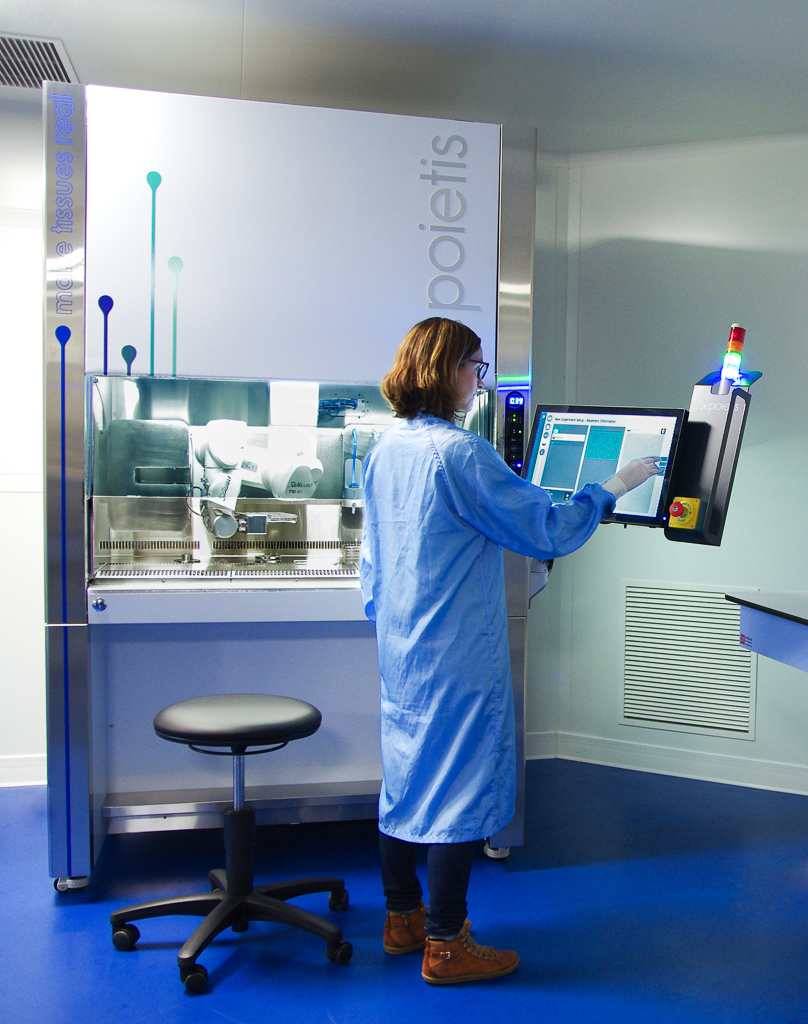During the next three years, French bioprinting startup Poietis will work with renowned cardiothoracic surgeon Philippe Menasché to develop a functional clinical-grade cardiac patch to treat heart failure. The collaboration aims to bioprint an implantable patch that will overcome the limitations of 20-year-old injectable therapies that have attempted to remuscularize an injured heart.
For this joint effort, titled “Regenerative Therapies of Cardiac and Vascular Pathologies,” the team will begin by evaluating the efficacy of a bioprinted material on a heart failure model for an animal in vivo, followed by clinical trials within three to four years. Although the researchers at Poietis and Menasché have prioritized the treatment of heart failure for this project, the co-developed patch could eventually be used to help treat other medical needs, like skin healing, eye disease, and certain inflammatory intestinal illnesses.
Weighing in on the new alliance, Menasché emphasizes that “heart failure is often the ultimate consequence of various cardiovascular diseases. Yet the combination of Poietis’ technological expertise in bioprinting with ours in stem cell therapies, or the bioactive factors they produce, could lead relatively quickly to a new therapeutic strategy.”

Renowned French cardiothoracic surgeon Philippe Menasché. Image courtesy of the University of Alabama at Birmingham.
Known worldwide for his pioneering work in stem cell therapy, Menasché is widely famous for having performed cardiac surgery and stem cell therapy on F-1 legend Michael Schumacher following a horrific skiing accident in 2013 that left him paralyzed and unable to speak.
Specializing in stem cell breakthroughs, the French surgeon began developing a preserving solution for transplanted hearts in the mid-1990s (still widely used today) before evolving toward embryonic stem cells and their role in treating patients with heart failure. Then in 2000, he performed an autologous skeletal myoblast transplant, followed by the world’s first embryonic cell transplant on a patient with heart failure in 2014. The implantation of heart cells derived from human embryonic stem cells made it possible to treat patients suffering from severe heart failure. In addition, instead of using multiple injections, the stem cells were implanted in the form of a patch within a fibrin gel, a first success that was particularly encouraging.
With his colleagues at the Hôpital Européen Georges Pompidou, where he is Chief of the Heart Failure Surgery Unit, Menasché works non-stop on stem cell research and therapies to treat heart diseases and injuries. His lab uses small and large animal (including nonhuman primates) models of myocardial infarction to optimize cell delivery and survival-enhancing techniques through tissue engineering. Menasché’s objective is to translate his research to the clinical phase with end-stage heart failure patients who have exhausted conventional therapies.
Now Poietis could help take Menasché’s work to the next level and ultimately graft healthy cells onto patients’ hearts with bioprinting. This new translational research collaboration with an international team in cardiac surgery and a pioneer in cell therapy for heart failure “materializes the versatility of Poietis’ bioprinting platform and the extension of its application portfolio,” explains Bruno Brisson, Poietis’ co-founder, and director.
The biotech company specializing in the design of regenerative medicine therapies developed a unique 4D laser technology for the bioprinting of living tissue. Unlike conventional approaches to tissue engineering or extrusion bioprinting, their system allows cells to be positioned in three dimensions with micrometric resolution and precision. Since its foundation in 2014, the aim has been to design living tissue using cells and biomaterial that researchers can apply to manufacture products for regenerative medicine, preclinical research, and cosmetic uses–making a big difference in the testing of cosmetics and consumer products.
Piggybacking its high-resolution laser-assisted bioprinting technology, Poietis developed its Next-Generation Bioprinting (NGB) platform. Currently, the company markets two bioprinters, the NGB-R Bioprinter (commercialized for research applications) and the NGB-C Bioprinter (a clinical-grade, GMP-compliant system dedicated to clinical applications and challenges of industrial manufacturing of implantable tissues).
Recently, Poietis installed its NGB-C robotic system at the Hôpital de la Conception, which is part of the Marseille Public University Hospital System (AP-HM). The institution will start using the device as part of a clinical trial for grafting bioprinted skin tissue using patients’ cells, aiming to transplant them in humans. With Menasché also using the bioprinting platform as part of his research, Poietis is truly immersing its unique product locally and teaming up with some of the most advanced researchers in tissue engineering and regenerative medicine.
Subscribe to Our Email Newsletter
Stay up-to-date on all the latest news from the 3D printing industry and receive information and offers from third party vendors.
You May Also Like
Precision at the Microscale: UK Researchers Advance Medical Devices with BMF’s 3D Printing Tech
University of Nottingham researchers are using Boston Micro Fabrication‘s (BMF) 3D printing technology to develop medical devices that improve compatibility with human tissue. Funded by a UK grant, this project...
3D Printing Webinar and Event Roundup: April 21, 2024
It’s another busy week of webinars and events, starting with Hannover Messe in Germany and continuing with Metalcasting Congress, Chinaplas, TechBlick’s Innovation Festival, and more. Stratasys continues its advanced training...
3D Printing Webinar and Event Roundup: March 17, 2024
It’s another busy week of webinars and events, including SALMED 2024 and AM Forum in Berlin. Stratasys continues its in-person training and is offering two webinars, ASTM is holding a...
3D Printed Micro Antenna is 15% Smaller and 6X Lighter
Horizon Microtechnologies has achieved success in creating a high-frequency D-Band horn antenna through micro 3D printing. However, this achievement did not rely solely on 3D printing; it involved a combination...






























